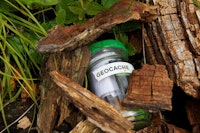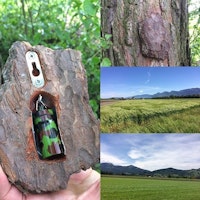
Geocaching is the world’s largest treasure hunt which involves ‘players’ hunting caches hidden in a variety of places. We are starting our very own CSC geocaches for campers and alumni to find and connect with all over the country! Be sure to ask your parents permission before setting off on a geocache adventure. If parents say it is okay, post your coordinates on Facebook or Instagram and tag Colvig Silver Camps! This guide will show you how you can make and hide your own geocache.
Try Finding Geocaches First
If you haven’t already, then make an account and give geocaching a go before you jump straight in and make your own. Spend a bit of time on this looking for several different types of caches. This will give you an idea of what works best, what you enjoyed the most and what you didn’t like about all the caches you found. It will also give you inspiration for locations, size of containers and what you could do differently. Check out geocaching.com to find local geocaches!
Read the Guidelines
Make sure you have read and fully understood the guidelines of the website you plan to list your cache on. geocaching.com has a short quiz to see if you are ready to make and post your own geocache. You must make sure your cache is in compliance with the website. If you just want to share your cache with CSC affiliate individuals, follow the guidelines on geocaching.com and share your coordinates on Facebook or Instagram, making sure to tag Colvig Silver Camps.
Decide on a Location for Your Cache
One of the most important parts of designing your cache is where to hide it. The location should be somewhere where people would enjoy spending the day looking for your cache, near something historic for example. Try not to choose somewhere near too much traffic, you don’t want non geocachers to stumble across your cache by accident. Make sure the cache is well hidden and this shouldn’t be a problem.
Double Check the Location
Your cache should not be near any other current geocaches as this could cause confusion with the co-ordinates. Caches need to be at least 528ft away from any other geocaches. Some parks require permits and others do not allow geocaching so make sure you have either obtained the correct permit or checked with park management that geocaching is allowed. If you plan on hiding your cache on private property then you must make sure you have permission from the land owner before you place your cache. Do not hide caches near airports, train stations or other places that might be deemed as terrorist targets.
Choose Your Container
Military ammo boxes are a popular container, but you could use almost any type of container as long as it is waterproof, airtight and durable. The size of your container will depend on how easy or hard you want your geocache to be to find. A large container in a great location however could still be pretty tricky to find if you hide it well! The type of container you choose will also depend on what you wish to put in your cache. Some caches are extremely small and difficult to find, but this also means that they can’t hold any items to swap or track as they are too small.

Make Your Cache!
You will need:
-Log book – this can be a small notebook or a roll of paper depending on the size of your cache.
-Small swappable items (optional)– these are commonly small trinkets or toys.
–Pencil/Pen
-Geocaching note: See Example Place the logbook, and the geocaching note in a zip-lock bag. The rest of the items can be placed in the cache. Labeling the cache is optional but a sensible thing to do is to avoid any issues if any non geocachers come across your cache.
Camouflage Your Cache
Camouflaging your cache is optional but highly recommended. This will be dependent on what type of container you chose and the location of your cache. Painting it in colours that will blend in to the surrounding area or gluing bark or leaves to the container can help conceal your cache.
Hide Your Cache
Use your imagination to make the cache hard to find, it’s not as fun when it’s too easy! Always be aware of the impact on the environment. For example, don’t hide your cache on a steep hillside where constant searches would damage and contribute to erosion. Choose a spot where fellow geocachers can search for it without being seen by too many passersby, you don’t want to draw unnecessary attention to the spot.
Find and Note Down the Co-ordinates
For others to find your cache they will need the co- ordinates. Make sure you have good signal then wait for a couple of minutes before marking the co-ordinates.
List your cache
The last step is posting it so that other geocachers can obtain the co-ordinates to find your cache. If you want fellow CSC campers and alumni to find your cache, be sure to post the coordinates on Facebook or Instagram and tag Colvig Silver Camps!
Maintain Your Cache
Your cache will be reviewed and you may need to move it if it’s too close another cache. Being the owner of the cache also means you’re responsible for maintaining it including replacing logbooks or repairing the cache should any damage occur.

Additional Resources
Still have a few questions about setting up or finding a cache? Check out these websites for more about how to safely and ethically enjoy geocaching!
